Samsung SSD 840 EVO mSATA (120GB, 250GB, 500GB & 1TB) Review
by Kristian Vättö on January 9, 2014 1:35 PM ESTRandom Read/Write Speed
The four corners of SSD performance are as follows: random read, random write, sequential read and sequential write speed. Random accesses are generally small in size, while sequential accesses tend to be larger and thus we have the four Iometer tests we use in all of our reviews.
Our first test writes 4KB in a completely random pattern over an 8GB space of the drive to simulate the sort of random access that you'd see on an OS drive (even this is more stressful than a normal desktop user would see). I perform three concurrent IOs and run the test for 3 minutes. The results reported are in average MB/s over the entire time. We use both standard pseudo randomly generated data for each write as well as fully random data to show you both the maximum and minimum performance offered by SandForce based drives in these tests. The average performance of SF drives will likely be somewhere in between the two values for each drive you see in the graphs. For an understanding of why this matters, read our original SandForce article.
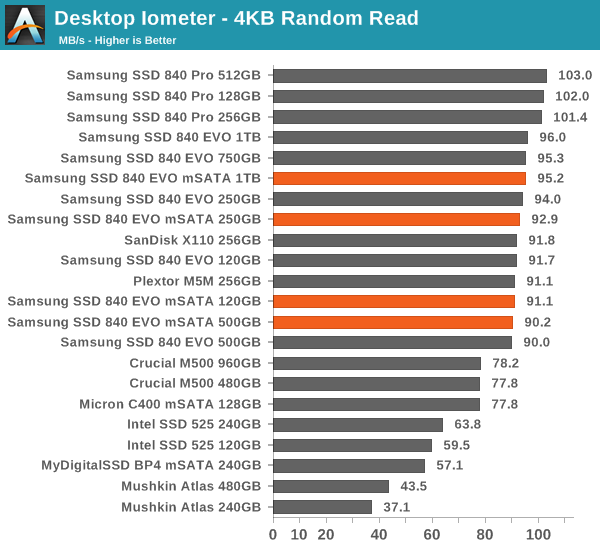
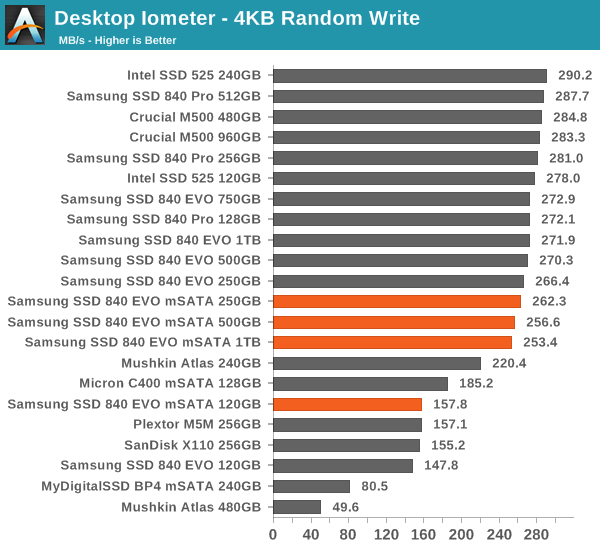
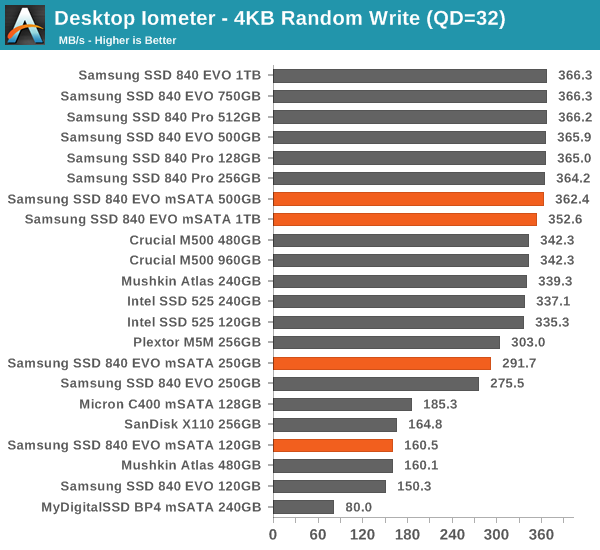
As expected, random IO performance is similar to the original EVO. There is some slight variation of course but nothing that stands out.
Sequential Read/Write Speed
To measure sequential performance I ran a 1 minute long 128KB sequential test over the entire span of the drive at a queue depth of 1. The results reported are in average MB/s over the entire test length.
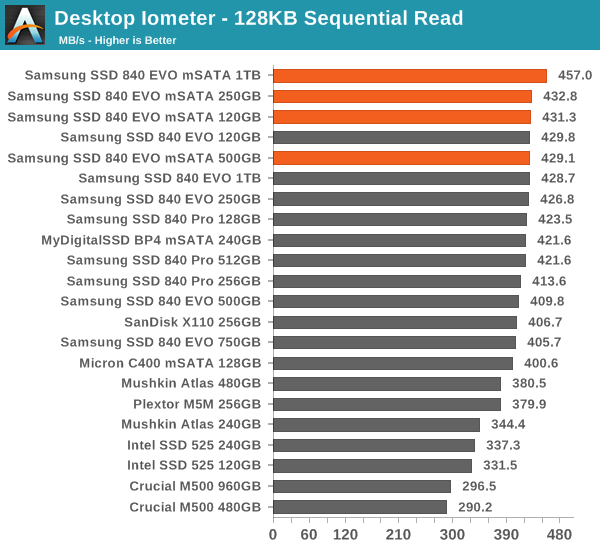
For some reason, the 1TB EVO mSATA is a few percent faster in 128KB sequential read test but falls short in the sequential write test. It's possible that the 16-die NAND has some effect on performance, which would explain the difference, but we're still dealing with rather small differences.
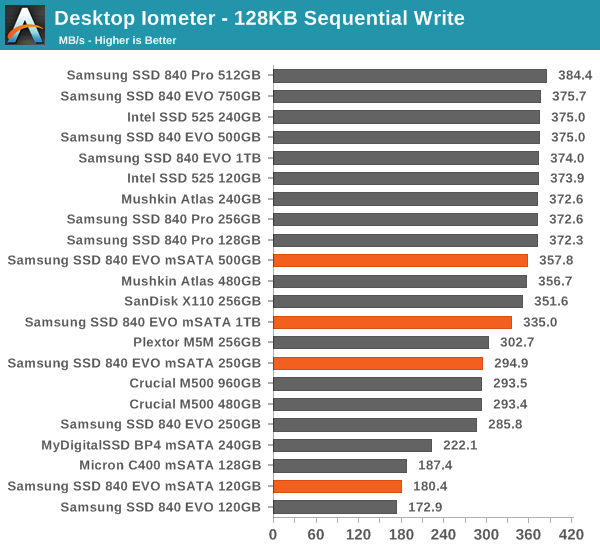
AS-SSD Incompressible Sequential Read/Write Performance
The AS-SSD sequential benchmark uses incompressible data for all of its transfers. The result is a pretty big reduction in sequential write speed on SandForce based controllers.
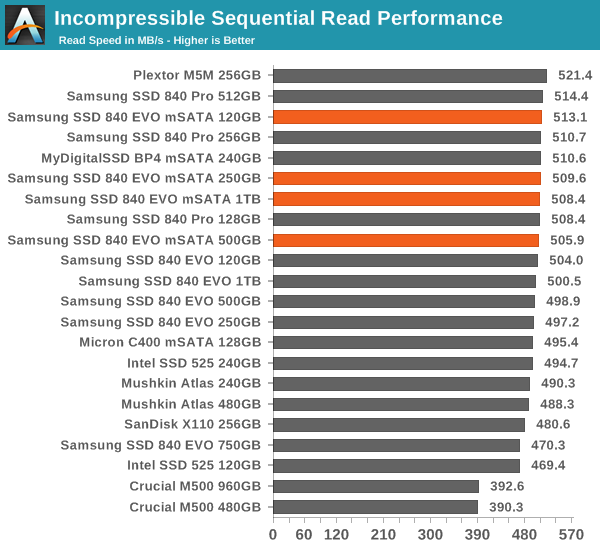
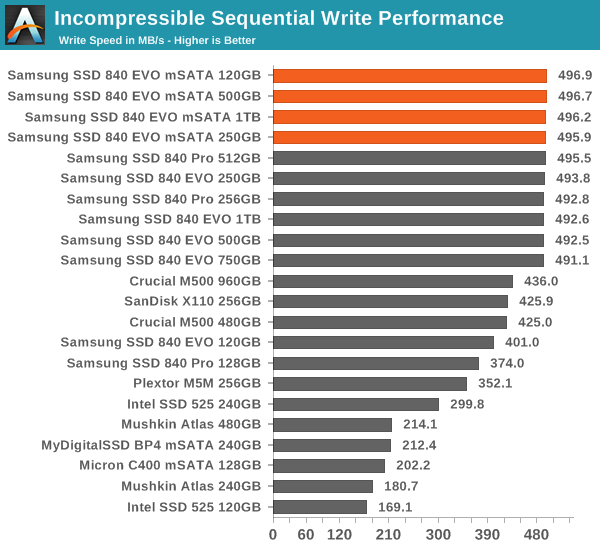










65 Comments
View All Comments
spejr - Tuesday, January 14, 2014 - link
Why do people still use mSATA? It might not make a difference for IOPS, but when opening a program the higher sequential read of PCIe would be a benefit. The NAND could supposedly go faster than 540.Kristian Vättö - Wednesday, January 15, 2014 - link
Because the support for PCIe is very limited. There are only a handful of laptops that use PCIe SSDs (and some of the have a proprietary connector like the MacBook Air) and in the desktop world all PCIe SSDs are currently just two or more SATA SSDs in RAID (though that will change during the next few months).bbordwell - Wednesday, January 15, 2014 - link
Any chance we could get an in depth review of Samsung's RAPID now that it is available on both the EVO and the PRO? I am curious if it would have a larger impact for writes on the PRO than the EVO since the PRO does not have the SLC write cache.RShack - Friday, January 17, 2014 - link
What % of your responses are to posters who evidently haven't bothered to even read the dang article?swiftdimension - Friday, January 17, 2014 - link
Just curious, if you guys connect a mSATA drive by letting it dangle connected to power and a SATA cable since the Asrock z68 Pro 3 doesnt have a mSata slot?Kristian Vättö - Saturday, January 18, 2014 - link
We use an mSATA to SATA 6Gbps adapter.Qlaras - Friday, January 17, 2014 - link
So I was considering ordering one of Gigabyte's sole AMD Brix - GB-BXA8-5545, and a 180-240GB mSATA SSD. (Now that the Brix is FINALLY released)Torn between waiting for the Samsung 840 EVO mSATA and just paying the premium for an Intel 525 and getting it now.
The Samsung has newer features/tech, and the price will (probably) be lower - MSRP matches what the 525 is going for now though, and the 525 comes with a 5-year warranty, versus 3 on the EVOs.
Thoughts?
Kristian Vättö - Saturday, January 18, 2014 - link
Crucial M500 should be a good compromise -- it's available now and the pricing is competitive.Coup27 - Saturday, January 18, 2014 - link
Did that maximum bus speed vs latency graph really come from Micron? It's clearly been drawn in MS Paint. The Y axis isn't even vertical!Good article nevertheless.
Kristian Vättö - Sunday, January 19, 2014 - link
Yup, here's the presentation (slide 9): http://www.flashmemorysummit.com/English/Collatera...